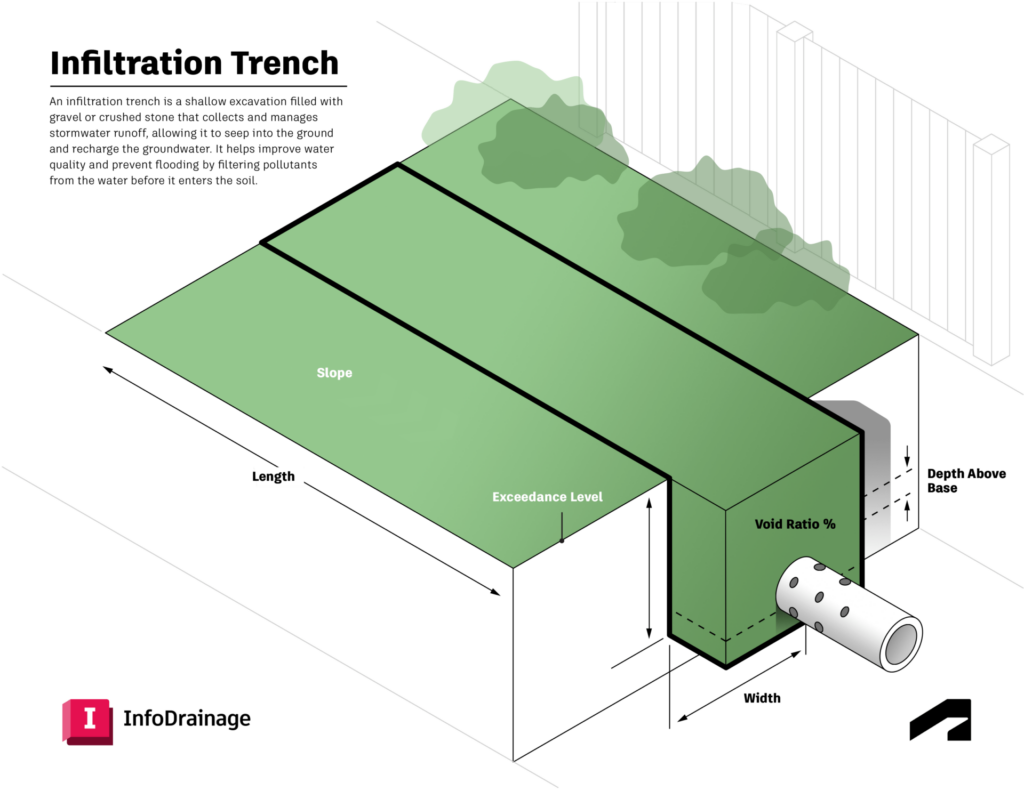& Construction

Integrated BIM tools, including Revit, AutoCAD, and Civil 3D
& Manufacturing

Professional CAD/CAM tools built on Inventor and AutoCAD
6 min read
As the world’s drainage challenges grow, designers are constantly looking for new ways to handle stormwater. Commonly known as stormwater controls (SWCs), a subset of sustainable drainage systems, known as SuDS (LIDs/BMPs/WSUDs), have grown popular globally. SuDS work with nature, rather than against, and can be seen as more sustainable means of handling stormwater inflow on a site.
One of the most popular SuDS globally are infiltration trenches, which are designed to manage stormwater runoff, improve water quality, and reduce the risk of flooding. These trenches are essentially shallow excavations filled with coarse aggregate, allowing rainwater to infiltrate into the ground rather than flowing directly into drainage systems.

By creating a highly permeable surface, water can be drained from a site relatively quickly and redirected to other SWCs, like ponds or natural streams and rivers. Let’s take a closer look at the components of infiltration trenches.
An infiltration trench typically consists of five main components:
So then, how do all these parts come together to deliver a more sustainable stormwater control system?
The operation of an infiltration trench can be broken down into four stages:
The processes of managing infiltration trenches in the drainage design process transcends just theory. Modern drainage design tools like InfoDrainage can accurately model the hydrologic behavior of these stormwater controls. With this level of insight, engineers and hydraulic modelers can know exactly how their SuDS will perform in the real world – before they get built.
These SuDS features inside our software are a big selling point for InfoDrainage because they make it easy to model exactly how they will work over time based on regional rainfall standards, either as standalone SuDS or as a linked system of SuDS. These kinds of sustainable implementations are most popular in the UK, where they are known as SuDS, but Americans may know them as LIDs or simply BMPs. Aussies call ’em WSUDs. No matter what acronym you choose to assign to them, they will become an increasingly important tool to help prevent flooding in cities as the planet warms and rainfall increases.
There is another very popular option for conveying stormwater: culverts. However, culverts do not have many benefits beyond moving water from one place to another around an obstacle – usually underneath a road.
Why use these? Lots of reasons:
As drainage designers know, more impermeable surfaces mean more runoff that a drainage design must handle. By designing with sustainable drainage systems, we’re able to deliver a drainage system that doesn’t simply create additional impermeability on the site. Rather, by working with nature to handle the flow, our drainage designs can be more efficient and effective at handling the ebbs and flows of increasing stormwater events.
It should be noted though that one of the downsides of infiltration trenches arises when dealing with highly contaminated stormwater flow. In most infiltration trench designs, designers will use vegetation strips or swales to slowly filter out larger contaminants that would clog up the infiltration trench aggregate. Frequent instances of high, turbulent flow in a region may reduce the design life of infiltration trenches as they collect and filter out more sediment that makes it past pre-treatment controls. However, when properly designed and implemented, these downsides can be mitigated.
Now that we have a good understanding of how infiltration trenches work, let’s explore how we can design with them inside of InfoDrainage.
InfoDrainage, a comprehensive site drainage design tool, has SuDS integrated into the application to facilitate the design and implementation of sustainable drainage solutions. This allows engineers and planners to model, analyze, and optimize infiltration trenches, including connecting them with other SuDS components if necessary to create an extremely accurate representation of reality and help ensure your site has effective stormwater management.
With InfoDrainage, you’re able to:
Because InfoDrainage has integrated SuDS, you can simply select infiltration trench as a SWC and add in the necessary dimensions and hydrology figures. You can adjust the dimensions, inlet and outlet details, infiltration rates, and pollution details. This feature can also be used to design different types of trenches like Trench Dry Wells or French Drains, with or without under drain pipes.
Want to know more about how they work? The InfoDrainage documentation covers all of the details, and these details are also covered in our free Understanding SuDS design course.
Want to try InoDrainage? We offer a 30-day free trial with no credit card required. Are you a student or educator? If so, we have some very good news for you.
Sign up for the One Water Blog newsletter, and we'll keep you updated about our top stories, along with the best content we find online. We only send out a newsletter when we have something interesting to share.
May we collect and use your data?
Learn more about the Third Party Services we use and our Privacy Statement.May we collect and use your data to tailor your experience?
Explore the benefits of a customized experience by managing your privacy settings for this site or visit our Privacy Statement to learn more about your options.